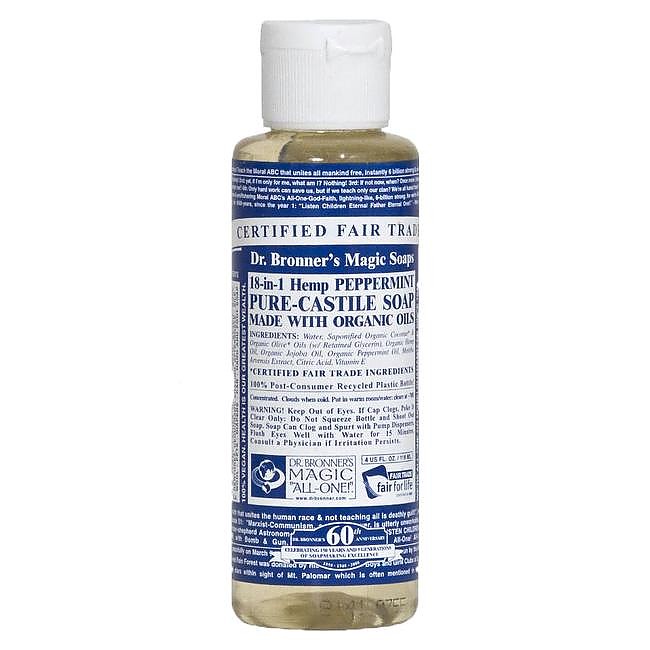Dr. Bronner Liquid Soap

Dr. Bronner's liquid soap has been a backwoods staple for as long as I can remember. This pure castile soap (meaning it is made using vegetable oil) is environmentally friendly and smells great.
Pros
- Smells good
- Environmentally friendly
- Helps to repel insects (for some scents)
- Has multiple uses
Cons
- Makes terrible deodorant
- Leaves suds behind
I was first introduced to Dr. Bronner's pure castile soap when I was about 8 years old. Back then, it was a camp staple as it was environmentally safe, and so could be used in the pond as well as the showers (try getting a hundred 8-year old boys to shower. Having them jump in a pond is much easier!).
INGREDIENTS: Castile soaps themselves aren't really anything special. They're just soap that uses vegetable oils in place of animal fats. It's the addition of the various essential oils that makes Dr. Bronner's so great in my eyes (and adds some of its many bizarre uses).
One nice benefit is that most companies who sell castile soap will leave the glycerine in (Dr. Bronner's is no exception here), meaning better moisturizing for you.
VARIATIONS: As long as I can remember, Dr Bronner's has come in Almond, Peppermint, and Lavender varieties. Today they also offer Eucalyptus, Rose, Citrus, and Unscented (baby) soaps. A few of these scents (peppermint, lavender, and eucalyptus) use essential oils that are known to naturally repel insects. (How I had managed to survive all those years at camp without getting eaten alive suddenly made sense when I realized this.)
USES: Back when I first discovered Dr. Bronner's, each bottle contained Emanuel Bronner's "Essential Vision and Philosophy" along with a list of uses. Long after we were all clean, this outrageous label was worth a few hours of entertainment. Sadly, they no longer print this information on each bottle (it's still on their website!), but I do remember it touting the many uses for Dr. Bronner's Liquid Castile Soap.
Supposedly, you could use it as soap, shampoo, toothpaste (even with the peppermint variety, I wouldn't recommend it...), mouthwash (again, I wouldn't recommend it), deodorant (Seriously, never try this one!), fruit wash, natural insect repellant, and I honestly seem to remember something about aliens on there somewhere.
While I can vouch for a few of these (it works wonderfully as soap, shampoo, and laundry detergent), there are others that I would strongly caution against. First of all, those of you who remember the days when swearing resulted in someone washing your mouth out with soap will know that soap makes bad toothpaste / mouthwash. Just because you use peppermint soap doesn't make it any more pleasant.
Next, it's always a bad idea to use soap as a deodorant. Even knowing this, I tried it (just once) on a particularly hot and gross trip through the Presidentials. I made it until about 15 minutes after the application before I went sprinting off to the nearest stream to wash off the burning. It took another 6+ hours for the pain to go away.
ENVIRONMENTAL CONCERNS: Everything made by Dr. Bronner's is fair trade, post consumer (for their packaging), and environmentally safe / biodegradable (more on biodegradability in a moment). They also bump the fat content to lead to "milder, smoother lather".
Still, there is noticeable lather left behind when you rinse off. If you're in a remote stream and use soap sparingly, this isn't an issue. However, if you're at a small pond near a campsite, you might unintentionally leave suds behind for the next person. These will go away in time and are environmentally safe, but they do spoil the view somewhat (and ruin the taste of the water for animals looking for a drink).
After a bit of research, I was able to verify that Dr. Bronner's Magic Soap, Liquid Baby Soap, Bar Soap, and Sal Suds cleaners have all been certified biodegradable to ISO-14593 standards. ISO-14593 testing involves taking a substance and adding it to a sealed container of oxygen, water, and some amount of microorganisms. If the soap is soluble in water, is volatile (breaks down), and is not harmful to the test microorganisms, then the test microorganisms will be able essentially to break it down and release the carbon contained in the soap. This will then cause the CO2 levels in the container to rise.
Only substances with a CO2 level above 60% (implying greater than or equal to 60% biodegradation) at the end of 28 days are considered to be ISO-14593 certified. Back in 2007, a 27 mg sample of Dr. Bronner's Magic Soap was tested and passed with 79% biodegradation according to AUA Test Report No. 8374/3.1-07.
Bear in mind that the above data shows that only 79% of a 27 mg sample was biodegraded at the end of 28 days. Also, the ISO-14593 test doesn't make claims (at least none that I have found) as to the biodiversity of the microorganisms included in each test or the impact to each type of microorganism. As with any soap in the backcountry, please use it sparingly and try not to contaminate the local water supply.
Source: bought it new
Your Review
Where to Buy
You May Like
Specs
| Price |
Current Retail: $3.79-$19.95 Historic Range: $2.89-$19.95 |


